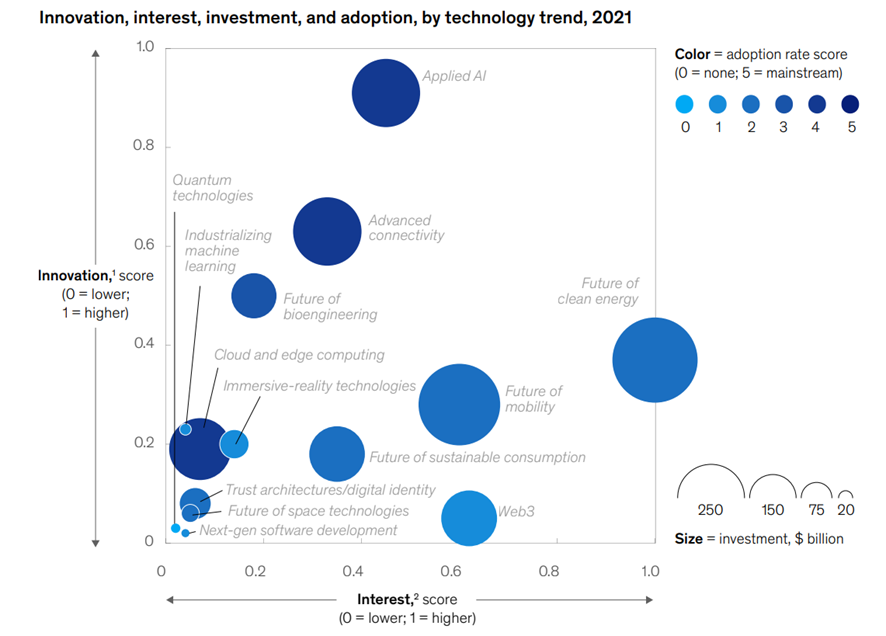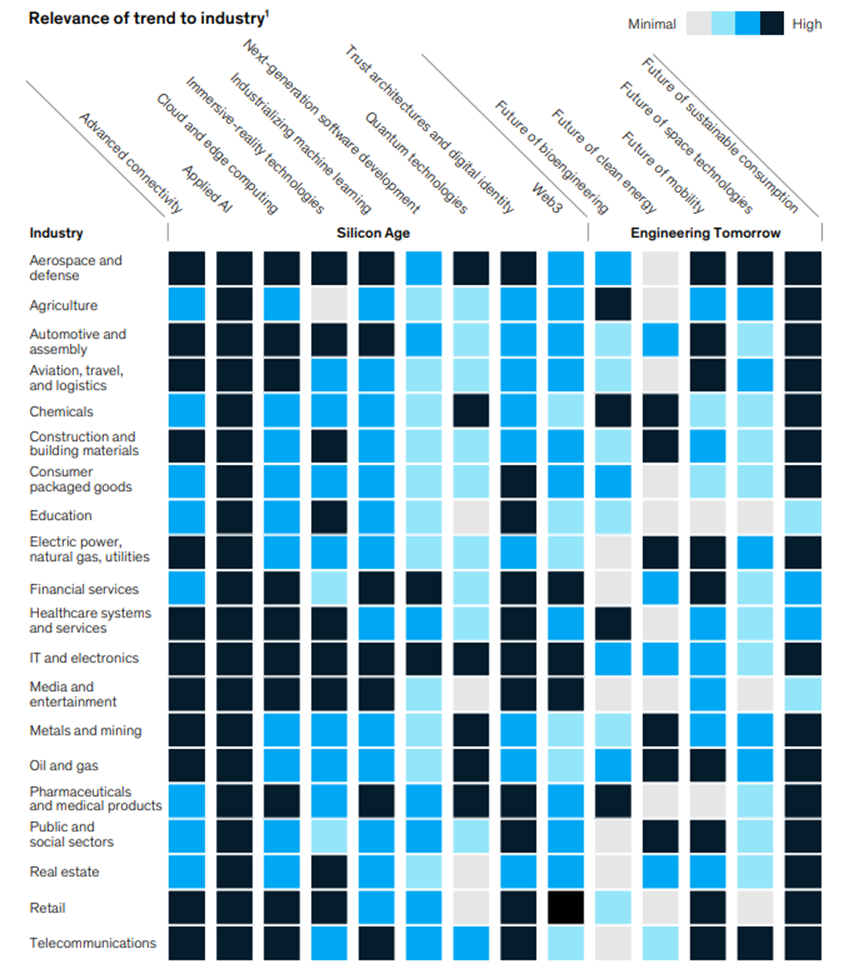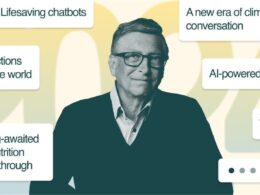Site editor:
Joaquim Cardoso MSc.
The Health Strategist — applied research, strategy and implementation
September 27, 2022
MGI
Research overview
Michael Chui, Roger Roberts, Lareina Yee
August 2022
Key messages:
First, several trends that are based on proven and mature technologies — namely applied AI, advanced connectivity, future of bioengineering, and cloud and edge computing — score more highly …
- … on quantitative measures of innovation, interest, and investment than trends based on technologies that are still in the early stages of development
- These trends also tend to have viable applications in more industries, which places them closer to a state of mainstream adoption than other trends
The next noteworthy group consists of trends that are closely aligned with sustainability priorities.
- These trends — which we call future of clean energy, future of sustainable consumption, and future of mobility — display increasing levels of innovation, interest, and investment.
- Indeed, of all the 14 trends we studied, the clean-energy and mobility trends attracted the most investment.
- They have also emerged as significant across multiple industries.
Outside the first two major categories, newer and less-proven digital tools power a set of emerging trends:
- industrializing machine learning, immersive-reality technologies, trust architectures and digital identity, next-generation software development, and quantum technologies.
- These trends could have major benefits for businesses.
Despite the uncertainty of these newer trends, it’s apparent that industries are broadly exposed to changes resulting from technological innovation and the diffusion of new technology-enabled business practices.
Several nascent trends also show a moderately close connection with many industries.
- Overall, we see that press coverage connects the automotive, manufacturing, telecommunications, and technology sectors closely to at least one trend and moderately to several others (Exhibit 2).
Infographic:
Exhibit 1 — Applied AI recorded the highest innovation score of all 14 trends, while clean energy drew the most interest and investment.

Exhibit 2 — Most industry sectors display a meaningful association with five or more technology trends.


Introduction
Technology continues to be a primary catalyst for change in the world.
Technology advances give businesses, governments, and social-sector institutions more possibilities to lift their productivity, invent or reinvent offerings, and contribute to humanity’s well-being.
And while it remains difficult to predict how technology trends will play out, executives can plan ahead better by tracking the development of new technologies, anticipating how companies might use them, and understanding the factors that affect innovation and adoption.
To that end, we have worked with the internal and external experts on the Technology Council to identify and interpret 14 of the most significant technology trends unfolding today .
This study builds on the trend research we shared last year, adding fresh data and deeper analysis to provide a more granular assessment of trends in two thematic groups:
- Silicon Age, which encompasses digital and IT technologies, and
- Engineering Tomorrow, which encompasses physical technologies in domains such as energy and mobility.
Our analysis examines such tangible, quantitative factors as investment, research activity, and news coverage to gauge the momentum of each trend.
We also conducted dozens of interviews and performed hundreds of hours of research to learn which industries are apt to benefit most as they absorb these technologies.
And, recognizing that trends can speed up, slow down, or change course, we examined the uncertainties and questions surrounding each trend.
This research overview, an accompanying online interactive, and a set of 14 in-depth trend profiles lay out these considerations in more detail so that executives can better comprehend how the individual trends are developing and interacting, and what these developments might mean for their organizations.
Looking across the trends, we also arrived at some general observations that leaders might find instructive.
New dynamics
First, several trends that are based on proven and mature technologies — namely applied AI, advanced connectivity, future of bioengineering, and cloud and edge computing —…
… score more highly on quantitative measures of innovation, interest, and investment than trends based on technologies that are still in the early stages of development.
These trends also tend to have viable applications in more industries, which places them closer to a state of mainstream adoption than other trends (Exhibit 1).
Exhibit 1
Applied AI recorded the highest innovation score of all 14 trends, while clean energy drew the most interest and investment.

Note: Innovation and interest scores for the 14 trends are relative to one another. All 14 trends exhibit high levels of innovation and interest compared with other topics and are also attracting significant investment ($2 billion minimum in 2021).
1 The innovation score combines the 0–1 scores for patents and research, which are relative to the trends studied. The patents score is based on a measure of patent filings, and the research score is based on a measure of research publications.
2 The interest score combines the 0–1 scores for news and searches, which are relative to the trends studied. The news score is based on a measure of news publications, and the searches score is based on a measure of search engine queries.
The next noteworthy group consists of trends that are closely aligned with sustainability priorities.
These trends — which we call future of clean energy, future of sustainable consumption, and future of mobility — display increasing levels of innovation, interest, and investment.
Indeed, of all the 14 trends we studied, the clean-energy and mobility trends attracted the most investment.
They have also emerged as significant across multiple industries.
Outside the first two major categories, newer and less-proven digital tools power a set of emerging trends:
industrializing machine learning, immersive-reality technologies, trust architectures and digital identity, next-generation software development, and quantum technologies.
These trends could have major benefits for businesses.
For example, industrializing machine learning (ML) can shorten the production time frame for ML applications by 90 percent.
But much work must be done to develop, refine, and commercialize the technologies that underpin these trends.
As a result, it’s unclear how long it will take for these trends to be adopted in multiple sectors, let alone to realize the potential seen by proponents.
industrializing machine learning (ML) can shorten the production time frame for ML applications by 90 percent. But much work must be done to develop, refine, and commercialize the technologies that underpin these trends.
Despite the uncertainty of these newer trends, it’s apparent that industries are broadly exposed to changes resulting from technological innovation and the diffusion of new technology-enabled business practices.
When we looked at how frequently news reports mentioned companies in 20 sectors alongside different trends, we found that most of these sectors display a meaningful association with five or more trends.
The mature and sustainability-focused trends described above exhibit a close connection with multiple industries.
Several nascent trends also show a moderately close connection with many industries.
Overall, we see that press coverage connects the automotive, manufacturing, telecommunications, and technology sectors closely to at least one trend and moderately to several others (Exhibit 2).
Exhibit 2
Most industry sectors display a meaningful association with five or more technology trends.

¹Relevance estimated qualitatively by industry experts based on trend’s potential to affect an industry; degree of relevance is scaled at both trend and industry levels.
We plan to explore the effects that technology trends are having, and could have, on sectors in more depth over the coming months.
Looking ahead
We expect changes like these will accelerate and intensify in the years to come, much as they have during the roughly three decades since the start of the internet revolution.
The changes will not only alter the competitive landscape but also exert ever-more powerful effects on society: reshaping markets, boosting productivity, spurring economic growth, and enhancing lives and livelihoods.
When we look at these trends, what impresses us more than anything else is the massive effect that technology will have on every sector.
The next few decades promise to be a time in which technologies progress ever-more quickly from science to engineering to impact — at scale, and around the world.
We also expect to see the multiplying effect of “combinatorial innovation,” as different technologies come together in creative ways.
For example, this is happening now as organizations combine different technologies to create the metaverse and the many layers that make it up.
Research methodology
To assess the development of each technology trend, our team collected data on five tangible measures of activity: search engine queries, news publications, patents, research publications, and investment.
For each measure, we used a defined set of data sources to find occurrences of keywords associated with each of the 14 trends, screened those occurrences for valid mentions of activity, and indexed the resulting numbers of mentions on a 0–1 scoring scale that is relative to the trends studied.
The innovation score combines the patents and research scores; the interest score combines the news and search scores. (While we recognize that an interest score can be inflated by deliberate efforts to stimulate news and search activity, we believe that each score fairly reflects the extent of discussion and debate about a given trend.)
Investment measures the flows of funding from the capital markets into companies linked with the trend. Data sources for the scores include the following:
¾ Patents. Data on patent filings are sourced from Google Patents.
¾ Research. Data on research publications are sourced from the Lens (www.lens.org).
¾ News. Data on news publications are sourced from Factiva.
¾ Searches. Data on search engine queries are sourced from Google Trends.
¾ Investment. Data on private-market and public-market capital raises are sourced from PitchBook.
The associations shown on the industry heat map were derived by reviewing the news reports on each trend for references to specific companies within each of the 20 industries.
In addition, we updated the selection and definition of trends from last year’s study to reflect the evolution of technology trends:
¾ Trends added since last year’s study: industrializing machine learning, Web3, immersive-reality technologies, future of mobility, and future of space technologies
¾ Trends not carried over from last year’s study: next-level process automation and virtualization (now considered an implication of several trends) and next-generation materials (partially represented by other trends)
¾ Trends with adjusted definitions: next-generation software development (partly covered under future of programming in 2021), trust architectures and digital identity (partly covered by trust architecture in 2021), future of sustainable consumption (disaggregated from future of clean technologies), and future of clean energy (disaggregated from future of clean technologies)
¾ Trends with minor changes to definition: applied AI, advanced connectivity (previously called future of connectivity), cloud and edge computing (previously called distributed infrastructure), quantum technologies (previously called next-generation computing), and future of bioengineering (previously called Bio Revolution)













